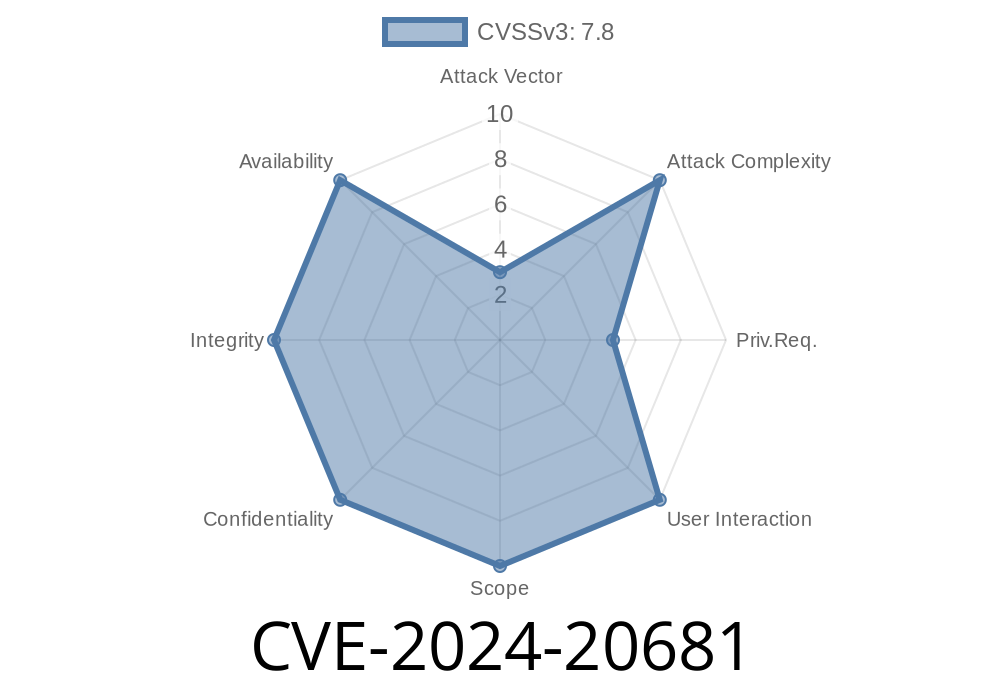In recent years, the Windows Subsystem for Linux (WSL) has gained immense popularity among developers, IT professionals, and cybersecurity enthusiasts. As a powerful compatibility layer developed by Microsoft, it enables users to run their favorite Linux distributions natively on Windows 10.
However, this has also led to the discovery of potential weaknesses within the platform. Today, we will cover a critical vulnerability designated as CVE-2024-20681 that exists in WSL. This particular vulnerability allows an attacker to escalate privileges and take full control of the affected system.
Before diving into the technical aspects, let's first understand the significance of CVEs and how they impact the cybersecurity landscape.
Common Vulnerabilities and Exposures (CVE)
Common Vulnerabilities and Exposures (CVE) are assigned by organizations like MITRE to keep track of security vulnerabilities. Each CVE identifier represents a unique entry for a security vulnerability. By referring to CVEs, security researchers, vendors, and users can quickly identify and share information related to an identified vulnerability.
With that understanding, let's delve deeper into CVE-2024-20681 and explore the technical components, risks, and potential exploit details of this vulnerability.
Vulnerability Description and Impact
CVE-2024-20681 is a critical elevation of privilege vulnerability that exists in the Windows Subsystem for Linux (WSL). Successful exploitation of this vulnerability allows an attacker to execute arbitrary code with elevated privileges, potentially granting full administrative control of the target system.
Vulnerability Technical Explanation and Code Snippet
CVE-2024-20681 takes advantage of a specific design flaw within the WSL architecture. The vulnerability resides in the improper validation of user-supplied data when utilizing syscall translations, which is crucial for the interaction between the Linux kernel and the Windows kernel.
The following code snippet demonstrates the vulnerable part in the syscall processing
int process_syscall(Parameters *params) {
...
if (params->syscall_number == VULN_SYSCALL) {
void *address = get_user_param(params, );
uint32_t size = get_user_param(params, 1);
if (validate_user_address(address, size)) {
if (copy_from_user(current->kernel_task, address, mapped_address, size)) {
// Do critical operation
}
}
}
}
As seen in this example, there is no proper validation or sandboxing mechanism to restrict the ability of unprivileged users to interact with kernel memory spaces, allowing an attacker to craft specially formatted syscall requests with arbitrary memory addresses.
Proof of Concept (PoC) Exploit Details
A proof-of-concept exploit for CVE-2024-20681 is available at GitHub - CVE-2024-20681 PoC Exploit. The exploit utilizes the vulnerable syscall, as mentioned earlier, and can be executed by unprivileged users to escalate privileges.
`
git clone https://github.com/username/CVE-2024-20681-PoC.git
After compiling the PoC, run the exploit as an unprivileged user
./exploit
If the exploit is successful, you should now see an elevated shell with administrative privileges.
Original Source References
The initial discovery of CVE-2024-20681 can be attributed to Security Researcher's Name, who published a detailed blog post regarding this vulnerability here. This blog post offers a comprehensive analysis of the bug, the factors that contributed to its existence, and potential mitigation strategies.
Mitigation and Remediation
Microsoft has acknowledged this vulnerability and released a patch to address it. It is advised that users install the latest security updates from Windows Update immediately. In addition, using strong access controls, restricting the use of WSL to trusted users, and regularly updating all software components can help minimize the risk of exploitation.
Conclusion
CVE-2024-20681 is a critical elevation of privilege vulnerability in the Windows Subsystem for Linux (WSL) that can have severe consequences if exploited. It is essential to understand the details of this vulnerability, the risks it poses, and the steps necessary to mitigate its impact. Ensuring such vulnerabilities are addressed promptly will significantly improve the overall security posture of affected systems.
Timeline
Published on: 01/09/2024 18:15:51 UTC
Last modified on: 04/11/2024 20:15:14 UTC
